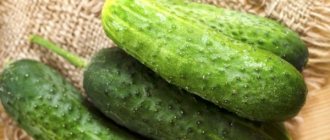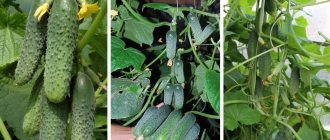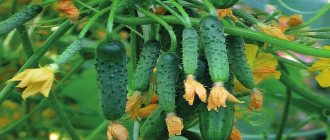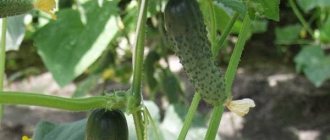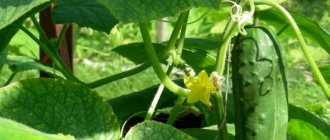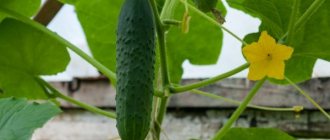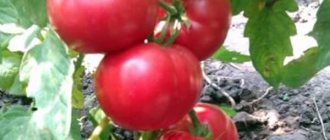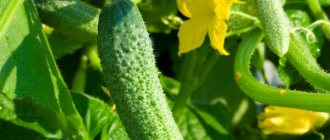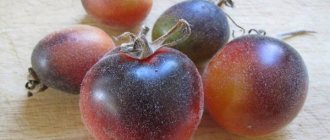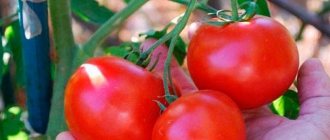Cucumber Christina f1 is ideal for growing in the country. The plant tolerates stress and unfavorable conditions well, produces a high yield of tasty fruits, which are especially good when preserved. But you can also prepare a fresh salad from them, which will also be appetizing and aromatic.
| Landing location | Ripening time | Mode of application | Fruit length | Group | Fruit smoothness | Pollination method |
| Universal | Early ripening (35-45 days) | Universal | Short (gherkins) - less than 10 cm | Hybrid | Highly lumpy | Parthenocarpic |
Characteristics of cucumber varieties for growing in open and closed ground
Cucumber varieties suitable for planting in a greenhouse or outdoors.
Cucumber Esaul
Refers to hybrids. It has a stable yield during fruiting, so you can grow seedlings without hassle. Vegetables begin to ripen 35-40 days after germination. The main characteristic is that the hybrid belongs to parthenocarpic varieties. The cucumbers are from 12 to 15 cm in length. The skin is tuberous.
The Monastic cucumber is pollinated by bees. The variety is early ripening, greens appear 30 days after sowing the seeds. The length of the cucumbers is from 13 to 15 cm, the skin is tuberous. It is distinguished by the presence of immunity to diseases. The taste of cucumbers is pleasant, the fruits are crispy.
Cucumber Suitor
Ugazher F1 is a late variety whose vegetables can be harvested until autumn. The advantage of the hybrid is stable yield. Cultivation is expected primarily in a greenhouse. The skin is coarsely tuberous, covered with white spines. The length of the greens is up to 20 cm.
The bushes are indeterminate. Branching and foliage are average. Cucumber Pharaoh F1 is a female variety, the inflorescences are predominantly of the female type. The skin is slightly ribbed, the shape of the greens is elongated, the length of the vegetables is from 15 to 20 cm. The description of the variety is that the hybrid is resistant to powdery mildew and rot.
Cucumber Sugar Baby F1 is a parthenocarpic, early-ripening hybrid. The plant rarely suffers from olive spot and powdery mildew. Greens grow from 7 to 9 cm in length. They are crispy, without a bitter aftertaste. Climbing is strong.
Cucumber Miracle Bouquet F1
A hybrid that is distinguished by strong branching and foliage. Vegetables reach up to 14 cm in length. Weight is no more than 100 g. Mid-early hybrid. Mass harvesting can begin 45 days after sowing. Ripe cucumbers of this variety taste sweet. Great for pickles.
Cucumber Harmony F1 is distinguished by its early ripening period. The leaves are medium sized, the bush is medium tall. Female type flowers. The skin is dark green with short light green stripes, covered with small tubercles and white thorns. Hybrid for salad purposes.
Picnic F1
The Picnic cucumber is an early ripening hybrid. The ripening period for greens is only 30 days. The flowering type is female; it is advisable to cultivate seedlings in greenhouse conditions. Zelentsy are cylindrical, slightly oval. Small, growing up to 9 cm in length. Finely lumpy, the skin is covered with small spines.
It is preferable to plant seeds of this variety in the ground in the first half of April. Early hybrid. The growth period before the appearance of greens is about 36 days. It is preferable to use for making salads. The length of the vegetables is from 9 to 15 cm. The skin is finely tuberculate. The weight of one cucumber is up to 140 g. Inflorescences form only the female type. The variety is suitable for growing in greenhouses. The foliage and climbing habit of the bush is average.
Cheerful Friends
Merry Friends is an early salad variety that can also be used for pickling whole. Bush of parthenocarpic type. The branching is weak, the bush is low. The flowers are of the female type. The leaves are small, light green in color. Greens have a cylindrical shape, they do not grow more than 7 cm in length. There may be light stripes on the peel.
Bobrik cucumber is distinguished by good yield and early ripening of fruits. Characterized by immunity to tobacco mosaic virus, cladosporiosis and powdery mildew. The length of mature greens is from 12 to 15 cm. The skin is often tuberous, white spines are located throughout the skin. The pulp is juicy, without a bitter aftertaste, crunchy. Female flowering type.
Chupa Chups
Chupa Chups F1 cucumbers are distinguished by good transportability. After harvesting, vegetables can be stored for a long time without spoiling. Parthenocarpic variety with early ripening greens. Cucumbers of this variety differ from all others in appearance. Their shape is round and in appearance they look like a very large gooseberry. The length of the fruit is up to 4 cm. The skin is thin, the flesh is not crispy, and does not taste bitter.
Mid-season hybrid of parthenocarpic type. Most often, the fruits are used to prepare vegetable salads. It is resistant to cladosporiosis. The length of the vegetables is from 13 to 15 cm. The skin is lumpy, the shape of the greens is cylindrical. The weight of one vegetable does not exceed 70 grams. The side shoots are well developed.
Cucumber Ladies' Caprice
A mid-season, high-yielding variety that is resistant to diseases such as olive spot, anthracnose and bacteriosis. You can use greens fresh, make lightly salted cucumbers and can them. The length of the vegetables is from 6 to 9 cm. The skin is medium-tubercular, thin. The flesh is crispy, there is no bitterness in the taste.
Characteristics of the variety
Characteristics of cucumbers of the Christina variety:
- Productivity 10 kg per 1 m².
- Fruiting time is 40-42 days. The variety is classified as early ripening.
- The fruits have universal significance, but more often the species is used for preservation.
The plant is parthenocarpic. Planting is carried out both in open and closed ground. When growing on site, it is recommended to cover the shoots with film. For ease of maintenance, you can use trellis frames. This will contribute to the uniform development of the lashes.
Christina F1 cucumbers grow in a temperate climate zone. The culture withstands unfavorable conditions and is suitable for country plantings.
Description of the bush
The weaving is medium branched, with accelerated growth. Female type flowering. The ovaries form 2-3 fruits. This type of formation of cucumbers controls their growth, so the fruits do not overgrow if the greens are unevenly harvested.
The leaves are dark green and medium in size. The bushes are indeterminate, with a powerful central stem.
Description of fruits
The fruits have the following qualities:
- length – 8-10 cm;
- diameter – 2.2 cm;
- weight of greens – 50-90 g;
The pulp has a crispy consistency and is free of voids and bitter aftertaste. The shape of cucumbers is cylindrical. The skin is covered with small bumps and white spines.
To obtain gherkins, you should harvest every two days. The variety is not suitable for growing pickles.
History of selection and description of the variety
The Palchik cucumber variety was bred by Russian breeders and entered into the Rosreestr in 2001.
Selection work was carried out at the Volgograd Experimental Station named after Academician Vavilov. The author of the variety is V. A. Shefatov. The plant is early ripening, the variety is suitable for cultivation in various regions. In the northern regions, greenhouse cultivation is recommended. The finger differs from other cucumbers in its long period of fruiting, reaching 60 days under favorable conditions. Due to their early ripeness, cucumbers of this variety have time to harvest before the massive appearance of a fungal disease such as powdery mildew in gardens. The bushes are covered with large dark green leaves, the fruits are bright green in color, and the color of the skin darkens with age. The originators of the variety declare the yield of this variety to be 6.8 kg/m².
Finger flowers are pollinated by insects. The taste of cucumbers of this variety is genetically without bitterness. The maximum weight of adult fruits reaches 110–130 g, and the length is 11–12 cm. The first fruits begin to ripen 42–46 days after the sprouts appear on the soil surface.
Did you know? The surface temperature of the cucumber and the internal temperature of the vegetable may differ from each other. Sometimes the temperature difference reaches 20°C.
Diseases and pests
Downy mildew, gray and white rot occur from excessive dampness. It is necessary to water the bushes moderately, treat them with whey, and sprinkle the affected areas with ash to prevent rot. Powdery mildew affects a bush that is overfed with nitrogen, especially when the roots are overcooled. Then the cucumbers are sprayed with a soap solution with iodine.
The same soap solution or insecticides will help against parasites. You can plant onions, garlic and dill next to the bushes, the smell of which will repel aphids and ticks.
Sources:
https://eda-land.ru/ogurcy/sorta/kristina-f1/ https://fermoved.ru/ogurtsyi/kristina-f1-opisanie-sorta.html https://repka.online/ovoshhi/ogurtsyi/rannespelyi /kristina-f1.html
Cucumber “Claudine f1”: improved qualities of the popular variety “Claudine F1”
The very early parthenocarpic hybrid cucumber "Claudine f1" is considered by many to be an improved form of cucumber called "Claudine F1". The hybrid form is included in the State Register of the Russian Federation and is intended for cultivation on ridges in open ground using temporary film cover in household plots.
The early improved parthenocarpic hybrid of cucumber-gherkin “Claudine-f1” is an achievement of the very famous and popular company Royal Sluis among vegetable growers.
Description of the variety
For a long time, it was the “Clavdia” variety that was popular among Russian gardeners, because formed “thin-skinned”, with a pleasant and refreshing dessert taste, elegant and “miniature” greens.
The plant forms medium-sized bushes, with well-growing shoots and bunched ovaries. The bushes are not only powerful, but also quite open, which makes caring for the plant and harvesting much easier. The foliage is lush and powerful.
The fruits do not exceed 10-12 cm in length and have a cylindrical shape, as well as a lumpy surface with a distinct green color. All greens have a uniform shape, high quality indicators and a dense consistency.
The average weight of one commercial herb is 85 g. The pulp is without bitterness, juicy and very crunchy, not only fresh, but also after processing.
The variety is very productive, the greens are tasty, sweet, crispy, with an ideal shape.
The hybrid form is characterized by good resistance to high temperature conditions and is characterized by field tolerance to cladosporiosis. According to the originator, there is intermediate resistance of the variety to the cucumber mosaic virus and powdery mildew. The total yield, subject to cultivation requirements and high agricultural technology, reaches 9.8-10 kg/m².
Landing rules
Cucumber variety "Claudine f1" requires the preparation of loose, fertile and porous soil. By the time the seeds are sowed, night temperatures should not fall below 8-10°C.
The hybrid form is recommended for cultivation on ridges in glass and film greenhouses, as well as tunnels. Cultivation in open ground is also allowed.
You can use both vertical and horizontal growing methods.
The variety has proven itself very well in spring-summer crop rotation. Depending on the fertility of the soil, mineral fertilizers in the form of 20-25 g of ammonium nitrate, 30-40 g of superphosphate and 15-20 g of potassium sulfate per square meter should be applied a couple of weeks before sowing the seeds.
The sowing pattern is 50x30 cm with a sowing depth of 2-3 cm. In order to protect against late frosts, it is recommended to temporarily cover early sowings with film on the arches.
Features of care
Gardeners note the unpretentiousness of the Claudine f1 cucumber, as well as its high level of resistance to a variety of unfavorable natural factors. To get a good harvest without significant material and physical costs, you need to follow these simple recommendations:
- if necessary, after the emergence of seedlings, the plants should be thinned, and the weakest ones should be removed;
- during the fruiting phase, the soil should be moistened quite abundantly, from the standard calculation of about 2.5-3 liters per square meter;
- In case of insufficient development and growth, it is recommended to feed cucumber bushes with any nitrogen fertilizer, including urea, ammonium or potassium nitrate, as well as ammophosphate at the rate of 8 g per bucket of water.
The main measures for caring for cucumbers include, in addition to thinning, watering and fertilizing, also loosening the soil, weeding, pinching shoots in order to form the plant and increase productivity. Harvesting is carried out as the greens ripen, which contributes to longer and more abundant fruiting.
After reading the corresponding article on our resource, you can familiarize yourself with the characteristics and rules for growing Phoenix cucumbers.
The cucumber variety “Claudine f1” has earned the most laudatory reviews, so it has every chance to take an honorable place among the most beloved hybrid forms among Russian gardeners.
The hybrid is characterized as mid-season and very resistant to a whole range of diseases, and also guarantees high yield.
Greens of this hybrid are ideal for pickling, canning and fresh consumption.
The variety is very reliable, has excellent germination and even in lean years produces quite a lot of marketable gherkins. Strict adherence to all agrotechnical care requirements during the growing season guarantees yields, which are often even higher than those declared by the seed manufacturer.
Reviews
Reviews about this variety are the most positive. They note its unpretentiousness and resistance to temperature changes, its ability to maintain freshness when stored in a cool place. They are very tasty both fresh and after preservation. Zelentsy are almost the same size, beautiful - this is also an important factor in choosing a variety.
The “Christina F1” cucumber variety can be grown both in summer cottages and for industrial purposes. The quality of this hybrid is no worse than its Western counterparts, but is positively distinguished by its ease of care.
In the next video you will find a review of the Christina F1 cucumber variety.
Features of cultivation
If you plan to plant cucumber seedlings, you need to sow the seeds in peat cups or in a greenhouse in early May. And when the sprouts acquire 2-4 adult leaves, you can plant them in open ground. The temperature must be at least 18 degrees, otherwise the seedlings will not grow
Note! The optimal period for planting is approximately the end of May - beginning of June. Before planting seedlings in the garden, you need to harden them for at least 7 days, taking them outside or onto the balcony. Before planting seedlings in the garden, you need to harden them for at least 7 days, taking them outside or to the balcony
Before planting seedlings in the garden, you need to harden them for at least 7 days, taking them outside or onto the balcony.
Seeds are sown in the ground from mid-May. They must be buried into the soil no more than 2 cm. Per 1 sq. There should be no more than 5-7 plants per meter. You can throw more seeds into the hole, then thin out the plantings and leave the strongest ones.
Advice! If you plant several different varieties next to each other, this will enhance fruiting.
Corn will be an excellent “neighbor” for a cucumber. It perfectly protects the fastidious crop from wind and drafts. It should be planted along the entire perimeter of the cucumber plantation, only the southern side should be left open.
If necessary, the sprouts can be covered with film.
Cucumbers of the Pharaoh variety are resistant to temperature changes, but it is important that it does not fall below 18 degrees. If this happens, it is important to cover the sprouts in a timely manner with film. Any soil is suitable for cucumbers, but soil poor in nutrients requires active feeding.
For example, just before planting, you can put a little humus in each hole. It must be rotted, fresh will simply destroy the plant
Any soil is suitable for cucumbers, but soil poor in nutrients requires active feeding. For example, just before planting, you can put a little humus in each hole. It must be rotted; fresh will simply destroy the plant.
You can fertilize cucumbers 5-6 times during the season, this will increase the number of ovaries, the fruits will grow of sufficient length and will be even.
Note! For cucumbers, there is nothing better than wood ash as a fertilizer. Ash should only be made from wood, no plastic or other synthetic materials. It is diluted in water and watered under each bush at the rate of 50-100 grams per square meter. m
It is diluted in water and watered under each bush at the rate of 50-100 grams per square meter. m.
Pharaoh cucumbers can be planted in one place for no more than 5 seasons. It is best to change the planting site every year, this will serve as protection against diseases and pests. The plant develops well in soil after peas, tomatoes, cabbage.
You can plant Pharaoh cucumbers in one place for no more than 5 seasons.
Cucumber vines can be directed onto trellises, while the lower side stems are cut off so that they do not spread along the ground. If the plant is not supported, the stems should not be moved; during harvesting, they must be carefully trampled. Damaged stems may dry out and the plant will die.
Description
The weaving of “Christina F1” with female-type flowering is medium-branched and develops rapidly. Two or three fruits are formed on the ovaries. This allows you to self-control the growth of greens, preventing them from overgrowing even with occasional collection.
Cucumber foliage consists of medium-sized, dark green leaves.
The bushes are indeterminate, that is, they can reach unlimited sizes. The central stem of the plant is very powerful.
Zelentsy reach 8-10 cm in length, each cucumber weighs 50-90 g with a diameter of 2.2 cm. The flesh is crisp, without voids, and there is no bitterness in it. Zelentsy have a regular cylindrical shape with small tubercles and white spines.
To use cucumbers as gherkins, they must be collected once every 2 days, but such cucumbers are not suitable for pickles.
Despite its unpretentiousness, the hybrid will surprise you with a rich harvest with good care, which involves:
- abundant watering to prevent the soil from drying out;
- feeding;
- weeding and lash assembly.
It is recommended to water the plant early in the morning using warm water. After irrigation, the soil should be loosened to prevent the formation of an earthen crust. Weeding and hilling should be gentle so as not to damage the root system.
You need to feed the plant at least once. Fertilizers with potassium and nitrogen are recommended for cucumbers. Fertilizing combined with watering is useful for them. For this purpose, infusions are made with onion peels, whey, diluted mullein or chicken droppings are used. But do not forget that such fertilizing often attracts the attention of harmful insects. If neighboring areas are infected with mole crickets or whiteflies, it is better not to use chicken droppings.
In order to improve the quality of greens, it is recommended to trim the vines. This is done seven days before fruiting. At the same time, the lateral sprouts in the lower part of the bush are removed, without touching the central stem and the upper lashes, which form future greenery.
Possibilities
AKADO Telecom provides a number of advantages for its clients:
- Access to the service even when the Internet is blocked or unpaid. You can make changes to the services provided or pay a bill without leaving your home and without spending mobile Internet traffic. It’s quite easy to forget to pay for the Internet, which is why there is an automatic payment function.
- Automatic payment settings - on the last day of the month or a specific day of the week, the option will save you from performing unnecessary actions and wasting time - you can view all transactions on the account in your account.
- The mobile application allows you to quickly manage services and use partner bonuses.
- The promised payment extends the use of digital services for 5 days, so as not to limit the user in case of unforeseen situations.
Features of cultivation
Cucumbers of the Stella variety can be sown immediately in protected soil. To obtain an earlier harvest, the seedling method is used.
Important! Cucumbers should not be replanted in the same place or after other pumpkins. The best predecessors are potatoes, tomatoes, legumes and green manure.
Planting cucumbers in seedlings
For planting, take seedlings 26–30 days old. At this time, the plant should form 3-4 true leaves. Overgrown specimens may lag behind in fruiting. The soil for cucumbers should be fertile and loose. It should be prepared in advance. In the spring, mineral fertilizers are added, for each square meter - 40 g of superphosphate, 15 g of ammonium nitrate and 25 g of potassium salt.
During autumn digging, manure is added - 4–9 kg per 1 m², depending on the type of soil. Planting is carried out when the daytime air temperature reaches +22…+24°С, and at night it is at +17…+18°С . When planting seedlings, maintain a gap between rows of 1-1.2 m, and between plants - 25-35 cm. There are 2-3 plants per 1 m². It is better to plant in the evening.
Find out more about planting cucumbers in open ground.
Holes for plants are formed so that the seedling material, along with the root system and a lump of earth, can be placed freely. Before planting, 3–4 hours before planting, the seedlings are moistened abundantly. Afterwards, the plants are carefully removed from the container and planted together with the soil in the prepared holes. Then the seedlings are covered with soil 2–3 cm above the root collar, compacting the soil.
If the seedlings were grown in peat pots, then planting is carried out together with them - the pot is placed in a hole and covered with soil two to three centimeters above its upper edge. After planting, watering is carried out at the rate of 1–2 liters per 1 hole.
Planting cucumbers with seeds
Cucumbers of the Stella variety are sown when the soil warms up to +15...+18°C. This time usually falls at the end of April - beginning of June, depending on the climate and region. 3 pieces of seed material are placed in the holes, with an interval of 10 cm from each other. The distance between rows is maintained at 35–40 cm.
The first shoots appear 6-8 days after planting. If the packaging does not indicate that the seeds have been treated, then they should be disinfected. To do this, the seeds are kept in a weak solution of potassium permanganate. Then you should rinse and dry, spreading it on a napkin.
Important! When planting seeds in open ground, they must be dried, since in soil that is not completely warmed up, the planting material may begin to rot.
Crispina cucumber: description, cultivation, care, photo
Cucumber f1 Crispina is a mid-season type of cucumber, derived by breeders from Holland. The seeds are produced in accordance with GOST, and were introduced into the Register of the Russian Federation in 2000. The variety is specialized for small garden plots, as well as not very large farms. According to the responses, “Crispina F1” cucumbers provide good yields both in greenhouses and in open ground.
Description of the variety
Crispin's cucumbers are a parthenocarpic hybrid, meaning they do not require pollination by bees.
For this reason, it can be grown in greenhouses of various types, as well as:
- The fruits are not very large in size, of the same shape and length. The greatest length of a cucumber reaches 12-13 cm, diameter - 4-5 cm, weight - 100 g. Model of an elongated cylinder, with large and frequent tubercles.
- The color is dark green with light longitudinal stripes and white pubescence. The flesh is rich, crispy, the skin is not compacted, without bitterness, with a small amount of seeds.
- Application. In the fresh version, they are suitable for salads and appetizers, excellent for winter pickles and marinades. Cucumbers have a long shelf life, for this reason they are suitable for trade and transportation.
- The bushes reach a mediocre size, with a small amount of foliage and a strong root system. The leaves are bright green, wrinkled and not large. A large number of stepsons are formed on the main stem.
- Harvest. Up to 4-5 cucumbers are formed on 1 node. They ripen 40-45 days after the first sunrise. The yield is significant: 10 kg/1 m2.
Characteristics of the variety
Crispina cucumbers are highly resistant to external conditions. Resistant to cold weather at an early stage of ripening and warm sun during fruiting.
This type of cucumber exceeds its own brothers in characteristics:
- high efficiency;
- unpretentiousness in courtship;
- resistance to temperature changes;
- disease resistance;
- versatility in application;
- excellent product quality.
Growing
It is more correct to plant Crispina F1 in closed ground as seedlings in pots. This makes it possible:
- First, purchase the earliest product
- Secondly, use fewer seeds to better protect the plants in the first stages of formation.
23-25-day-old seedlings are planted in glass greenhouses at the end of January - beginning of February, and in film greenhouses with air or solar heating, if the soil temperature is not lower than 17°C. Pots for growing seedlings are made from the following consistency:
- 3 parts peat;
- 1 part humus;
- or 3 parts of humus;
- 1 part of turf land.
Add to this consistency per 1 ton:
- ammonium nitrate 0.8-1.0 kilograms;
- superphosphate 1.0-1.5;
- potassium sulfate 0.7-1.0 kilograms.
Use pots with a diameter of at least 8 cm. It is necessary to ensure that the pH consistency is 6.2-6.5.
Instead of pots, it is more correct to use specialized tablets:
- They are easy to use, include macro- and microelements and biologically active substances necessary for plants.
- In addition, treating seedlings with special substances can be very useful.
Do you use peat tablets?
The seed sowing period is chosen so as to plant 22-25 day old seedlings (3-4 leaves) in open ground within the recommended time frame.
Nunems seeds undergo all necessary pre-sowing treatment in Holland and do not require any other processing.
After sowing, until the emergence of seedlings, the temperature is kept within 25-28°C, with the emergence of seedlings it is reduced during the day to 18-20°C, at night to 14-15°C, moderate watering and timely ventilation are performed.
A sudden drop in air and soil temperatures at night can cause lodging of seedlings and, on the contrary, overheating of the air at night can cause seedlings to stretch out and reduce their quality.
Seedlings must be well hardened before planting in film greenhouses.
Soil preparation
The soil for planting is prepared in advance:
- The root system of Crispina F1 is relatively well formed; for this reason, it is best to form small ridges along future rows, into which some mineral fertilizers and humus are added. This guarantees the best conditions for plant formation.
- The height of the beds in closed ground is 15-20 cm, the distance between rows is 0.9-1.0 m.
- The distance between plants in a row is 35-45 cm, depending on the row spacing. In each case, there should be approximately 200-250 plants per 100 m².
- Drip irrigation tubes are placed at a distance of 5-20 cm from the planted seedlings. Drip irrigation makes it possible to significantly save water consumption when watering, and in addition, introduce mineral fertilizers and plant protection products against a complex of soil pests and causative agents of cucumber diseases.
- Covering the ridges with a mulch shell has proven itself well.
Bush formation
In greenhouses, Crispina F1 is formed into one stem with side shoots. If the plants have 6-7 nodes, blind the lower part of the stem:
- at the first 5 nodes, fruits and stepsons are completely eliminated, preserving the main stem;
- At the next 3-4 nodes, the stepsons are pinched, but 1 fruit is retained on each node.
This method makes it possible to secure young plants and acquire the largest early harvest, but that’s not all:
- After this, all the fruits are saved at 4-5 nodes and the stepsons above the first leaf are pinched.
- Next, the stepsons are shortened by 2-3 leaves, depending on the thickness.
- After the central stem of Crispina F1 reaches the top of the trellis, it is oriented along the row and at a distance of 0.7-1 m and directed downwards. The central stem is pinched at a distance of 0.9-1.0 m from the ground.
- As they age, remove the lower leaves that have begun to turn yellow or become very thick in the planting.
This method makes it possible to improve the ventilation of the entire greenhouse and thereby avoid plant diseases.
Fertilizer
Crispina F1 plants form a strong above-ground part, for this reason the nutritional regime must be at a significant level.
They have a strong root system, which responds well to the introduction of high-calorie substances, especially when supplied locally through a drip irrigation system.
After 1-2 selections of fruits, the plants need to be fed with nitrogen-potassium fertilizers. It can be:
- organic (solution of manure, bird droppings) fertilizers
- mineral (a mixture of ammonium (calcium nitrate)
- potassium sulfate (more correctly potassium magnesium or potassium salt).
In greenhouses, when applying mineral fertilizers, it must be borne in mind that nitrogen must be introduced in nitrate form, and in ammonium form no more than 20% of the final nitrogen application in mineral form. If possible, it is more correct to apply fertilizers in dissolved form with irrigation water using a drip irrigation system. Feeding is repeated every 10-14 days.
Care
The principles of growing the Crispin cucumber variety take into account proper care of the bush:
- Cucumbers belong to light-loving plants. It is recommended to plant them in well-lit places. Simple partial shade is allowed.
- The selected location should be well protected from the wind. The south side is not closed.
When growing plants in open ground, it is possible to use corn as a living windbreak. It is sown in one row on both sides of the cucumber bed.
- For standard plant formation, the daytime temperature must be at least 22 degrees. With short-term changes in night and day temperatures, Crispina feels in accordance with the norm and does not delay formation.
- But even small frosts can destroy seedlings. In order to avoid this, it is necessary to cover the plants at night.
- Cucumbers belong to those crops that prefer significant humidity and frequent watering. The latter are very significant throughout the entire growing season and fruiting stage. If there is a lack of moisture, even the type of Crispin, which does not contain bitterness, may turn out to be partially bitter. It is recommended to use warm water for irrigation. When watering with cold water, the plant is depressed and rot may appear.
- In order to preserve soil moisture, the bushes are mulched with organic materials. They not only retain moisture, but also rot over time, releasing heat and enriching the soil with the necessary components.
Frequent watering leads to soil compaction. In order for the roots to breathe, it is recommended to alternate watering with loosening the soil. But this must be done not by traditional methods, but by piercing the soil with a garden fork. This kind of method will protect the delicate surface roots of the plant from damage and allow the root system to breathe.
Diseases and pests
Cucumbers of the “Crispina F1” variety are characterized by great resistance to various diseases:
- powdery mildew;
- regular mosaic;
- cladosporiosis.
To prevent pests from affecting the plant, cucumbers are treated with various fungicides. Spraying is carried out before fruit appears. As a rule, protection against powdery mildew and rot is used.
Among the pests, the plant is most affected by aphids. In order to fight it, it is recommended to treat plants with aphid preparations at least twice before fruiting begins.
In addition, near the cucumber beds they are fighting ants.
Photo
In the photo you can see Crispin's cucumber.
You can also watch a video where they will tell you what the main distinguishing features of the Crispina variety are and what the seeds look like.
Proper cultivation will make it possible to harvest large harvests of delicious cucumbers with crispy, appetizing, fragrant pulp.
Source: https://prodachnika.com/ovoshi/ogurtsy/krispina.html
Description of the variety
The variety is bee-pollinated, therefore it is intended primarily for open ground, where it is provided with access to pollinating insects. Film covers for cucumbers are used as temporary covers at the initial stage of growth.
All original varieties of cucumbers are propagated by cross-pollination carried out by insects
The yield of bee-pollinated varieties (as opposed to self-pollinated varieties intended for greenhouses) largely depends on external factors: temperature changes, cloudy weather, insect activity. “Bush” cucumber is planted with seedlings or direct sowing of seeds in prepared beds from May 10 to June 10, when the soil is warmed to +15...20 ℃ during the day and not lower than +8 ℃ at night. Under favorable conditions, this variety is capable of providing the maximum yield declared by the manufacturer: up to 5-6 kg/m2 of fruits that have a leveled presentation.
The main difference and advantage of bush cucumbers is the compactness of the plants that do not require formation
The main advantage of the variety is the compact size of the plants, which do not grow into thickets, but are more reminiscent of miniature zucchini bushes. Thanks to this, they do not take up much space and are suitable for small plots of land. In addition, “Bush” does not require constant pinching of side shoots and formation. The plants are determinate (the growth of the central stem stops after the flower cluster is established at the level of 60-70 cm), with moderate branching and short vines (35-60 cm), leaf axils and internodes are shortened, due to which the leaf mass looks abundant.
The drip irrigation system for cucumbers greatly facilitates plant care
The recommended planting density for bush cucumbers is 70 x 30 cm. When growing, it is enough to adhere to standard agrotechnical requirements: water regularly, feed in a timely manner, mulch the soil or perform weeding and surface loosening. Bush forms are considered the most unpretentious, easy to care for and harvest.
Cucumber and gherkin varieties are considered one of the best for pickling and pickling
Zelentsy are short (9-12 cm long), weighing on average 100-110 g, have an elongated ovoid shape, weak ribbing and dark green color with short light stripes. The peel is not dense, covered with large tubercles and black pubescence. The excellent taste, crunch and juiciness of greens ensure versatility of use: they are highly valued as salads for fresh consumption, and are also ideal for all types of homemade preparations (pickling, canning). The fruits have good transportability and shelf life during long-term storage.
In the photo – packages of cucumber seeds of the “Bush” variety from various manufacturers
Since the “Kustovoy” cucumber is a bee-pollinated variety, its fruits ripen full-fledged seeds. Many gardeners prefer to collect their own seeds for further cultivation. Manufacturers offer both regular and processed seeds, coated with coatings using panning or encrusting technologies (which do not require pre-sowing preparation). The protective and nutritional coatings contain growth stimulants, approved pesticides, micro- and macroelements, which provide:
- increase in germination by 7-10%;
- increase in yield by 15-20%;
- protection from diseases and pests.
According to reviews from most gardeners, the “Bush” cucumber is resistant to olive spot (cladosporiosis), powdery mildew, bacteriosis, and is also hardy in unfavorable weather conditions, but does not tolerate heat and direct sunlight.
The photo shows ordinary cucumber seeds (Manufacturers offer both this variety and coated seeds.)
Peculiarities
The yield of the Christina F1 variety reaches 10 kilograms per square meter. The variety is early ripening, with a fruiting period of 40-42 days. Christina F1 cucumbers are delicious fresh and ideal for canning. The plant is classified as parthenocarpic because it does not require insects for pollination. It is grown both in open ground and in greenhouses.
When planting in open ground, it is advisable to cover the seedlings with film. For better development of lashes, the use of trellis frames is recommended.
The variety is optimal for growing in a temperate climate zone. It is resistant to adverse weather conditions.
Characteristics and description of the variety
This young species of cucumbers was included in the State Register of Russia in 2009 and has so far been approved for cultivation in the North Caucasus region (Chechnya, Ingushetia, Dagestan, Adygea, Krasnodar and Stavropol Territories, as well as the Rostov region) and the Lower Volga region (Saratov, Volgograd, Astrakhan region and Kalmykia).
The Satina F1 variety is hybrid and does not require pollination, so the presence of pollinating insects near the plantations is not necessary. The plant is recommended for industrial cultivation.
Appearance of the bush and taste of cucumbers
Indeterminate parthenocarpic (without pollination) bushes of medium size and branching. The dark green and rich green leaves are larger than average in size and provide excellent shade for the fruit. Cylindrical cucumbers with a slight edge and spikiness are of medium size and weight.
Typically, a kilogram includes 10–12 vegetables weighing 80–100 grams. The length of a cucumber is approximately equal to three times its diameter. Green and dark green fruits have unevenly spaced dark pimples with light spines. Towards the flower, the color becomes lighter with individual whitish strokes.
Did you know? “Russian cucumber” or “Cucumber in a Russian shirt” - this is what they call in Europe those fruits that have thorns. In Europe itself, they prefer smooth vegetables.
Satina pulp has excellent consumer qualities:
- there are no voids;
- uniform density throughout the fruit;
- crunchiness;
- lack of bitterness.
Fruitfulness
The variety is quite productive, for which it is respected by summer residents and is used by farmers for mass cultivation. At the beginning of fruiting, about 115 centners are harvested from one hectare, but during the period of technical maturity, the same plot can bring more than 400 centners.
The characteristic that distinguishes the fruits of this variety is their high quality - commercial products for these cucumbers account for up to 98% of the total harvest. This means that among the mass of cucumbers there will be a minimum of spoiled, shapeless and overgrown cucumbers.
Ripening and flowering dates
Plants bear their first fruits approximately a month and a half after planting with seeds and 30–40 days after seedlings take root. With low climbing capacity, this crop gives all its strength to the formation of fruits, not shoots, so the formation of ovaries occurs early, and they develop quickly.
Cucumbers planted in early May begin to bear fruit by mid-June. It is clear that in this case it is necessary to take into account climatic conditions and provide the plantation with daily care depending on the weather.
Features of care
In order for cucumbers to bear fruit well, they must be fed, irrigated, tied, loosened and mulched correctly and on time. We must not forget about protecting plants from diseases and pests.
Also read about how to properly pinch cucumbers.
Watering and fertilizing
Cucumber plants are very moisture-loving, so to obtain high yields, the vegetable grower must take care of the timely supply of water to the garden bed. Cucumbers should not be given a water shower; they cannot tolerate watering the leaves, as this provokes the rapid development of fungal diseases. This crop is watered only at the roots, so gardeners set up irrigation ditches not far from the planted plants or lay out drip irrigation tubes along the plant rows.
The most successful solution is to install a drip irrigation system, since in this case the required amount of moisture will be supplied to the root of each plant, and the low speed of water supply will not allow the liquid to erode the soil root layer. To water an adult plant, 2 liters of water 2 times a week or 5 liters of water weekly is enough. As needed, along with irrigation, liquid fertilizers are supplied to the roots of the plant.
This crop can be fertilized with liquid organic matter. The most suitable fertilizer for cucumber is fermented bird droppings, since it contains a high nitrogen content. A barrel or bucket with fermenting organic matter is placed next to a cucumber bed or in a greenhouse. Rotting organic matter supplies a sufficient amount of carbon dioxide into the air, which cucumbers love.
Important! The gardener needs to remember that fermented bird droppings are concentrated fertilizers that need to be diluted with water. For every 10 liters of clean water, add 500 ml of concentrated liquid fertilizer. How to prepare liquid organic fertilizer at home:
How to prepare liquid organic fertilizer at home:
- It is necessary to find a large container with a lid that is unnecessary in the household. The tank is installed in a warm, sunny place outside or in a greenhouse, after which it is filled with bird droppings. You can take both dry and fresh droppings. The excrement of pigeons, ducks, geese, ostriches, and chickens is suitable for these purposes.
- Water is poured into the tank over the droppings, making sure that its level does not reach 15–20 cm from the edge of the container. This gap is necessary for the fermentation of the liquid. The contents of the tank are mixed using a long and strong stirrer, after which the container is tightly closed with a lid. The solution of manure and water is left to ferment for one or two weeks. The higher the air temperature, the faster the fermentation of the fertilizer in the tank occurs.
- The contents of the tank must be stirred daily to release carbon dioxide from the fermenting mixture. Bubbles will no longer appear on the surface of the finished liquid fertilizer.
Garter and bush formation
Cucumber fruits should not be allowed to come into contact with the soil to prevent them from rotting. The cucumber is a climbing vine, so it can be tied to a support. In open ground, plants are tied to a trellis or support stakes. In closed ground, cucumber bushes are tied to vertically fixed ropes or a support mesh.
Soil care
Throughout the summer, the gardener must ensure that the soil between the cucumber rows is free of weeds. As soon as weeds emerge, the bed needs to be weeded using a hoe or a Fokin flat cutter. After heavy rains, the soil may become compacted, so it must be loosened using the same garden tools. Weeding is carried out every 10 days, loosening - after heavy rainfall.
Read more about how to deal with barren flowers on cucumbers.
Pests and diseases
The hybrid origin of the Christina F1 variety allows it to avoid many common diseases. However, timely prevention will help to completely reduce the risk of infection and protect the bushes from pests. Treatment is carried out once per season, before fruiting begins.
The early ripeness of the variety does not allow the use of potent agrochemicals. Such mixtures can lead to fruit toxicity. Most prophylactic solutions can be prepared at home using organic and mineral products:
- Powdery mildew is a common disease in cucumbers. The cause is hypothermia of the root system. The disease also occurs due to a greater amount of nitrogen in the soil. As a preventive measure, you should use a milk-based solution with the addition of iodine and soap.
- Increased humidity in the area leads to the appearance of peronosporosis. Fermented milk products will help prevent disease. They should be applied at the root of the bushes.
- White and gray rot affect the root system and stem. The cause is excess moisture. In the fight against the disease, a urea solution should be used. 10 g of product is diluted per 10 liters of liquid.
Diseases are less of a threat to hybrid varieties. Pests cause a lot of damage to bushes. Some of them attack the stems and root system. Others destroy the fruits.
The most common harmful insects are aphids and slugs. Pest prevention should be carried out in the fall, when preparing the soil for winter. Before frost, the soil should be dug up and left to freeze. This is to destroy pest larvae and weed seeds.
Heat-loving crispy fruits - cucumber Christina f1: detailed description of the variety
Cucumber Christina f1 is ideal for growing in the country. The plant tolerates stress and unfavorable conditions well, produces a high yield of tasty fruits, which are especially good when preserved. But you can also prepare a fresh salad from them, which will also be appetizing and aromatic.
| Landing location | Ripening time | Mode of application | Fruit length | Group | Fruit smoothness | Pollination method |
| Universal | Early ripening (35-45 days) | Universal | Short (gherkins) – less than 10 cm | Hybrid | Highly lumpy | Parthenocarpic |
Description and characteristics of the variety
Each node develops 2-3 ovaries. Cucumbers ripen on the 40-42nd day from the moment of seed germination. Small fruits can be collected in the form of gherkins, but they are not suitable for preparing pickles (young cucumbers up to 5 cm in length).
Description and characteristics of the fruit: the length of the greens reaches 8-10 cm, it is about 2.2 cm in diameter. The average weight is 50-90 g. There are pronounced tubercles and white spines on the skin. The pulp is tasty and juicy, with a wonderful aroma, crispy. Its qualities become even better when canned, but the hybrid is also suitable for fresh consumption.
Advantages and disadvantages
- great taste;
- high productivity;
- rapid ripening;
- good endurance to adverse conditions;
- self-pollinating;
- good presentation;
- immunity to major diseases.
Minuses:
inability to collect seeds from your own harvest.
Landing
You can grow the hybrid in seedlings if the garden is located in the middle zone and in the north, or sow directly into the ground if the summer in the region is long and the fruits have time to ripen.
To plant seeds in the beds, the area is dug up deeply in the fall and at least a bucket of humus or compost is added per 1 square meter. m. In the spring you can dig it up again. When the soil warms to a depth of 12 cm to at least +15 degrees, you can sow the seeds.
For 1 sq. m can freely accommodate 3-4 bushes. After sowing the seeds in the holes, they are sprinkled with earth and mulched or covered with film.
Seedlings are sown at the beginning of April (for transplanting into a greenhouse) or at the end - for open ground. You will need peat pots 10-12 cm in diameter and a loose nutrient substrate. 1-2 seeds are planted in each container, then moistened, covered with film and placed in a sunny place. After germination, the temperature in the room is fixed at +18-20 degrees.
Watering
Cucumbers need abundant watering, but do not allow moisture to stagnate in the soil - this leads to the formation of fungi. Use warm water and pre-settle it in the sun. It is better to water in the morning.
At the beginning of plant development, an average of 6 liters of water per 1 square meter is added. m (after heavy rain, you can not water or reduce the rate by half). When the ovaries appear, at least 10 liters per 1 square meter will be required. m. You need to water every 2-4 days depending on the weather.
Fertilizer
Fertilize the bushes at least once per season, but 2-3 times is better. It is necessary to alternate organic and mineral products. The following are used as organic fertilizers:
- infusion of onion peel;
- cow manure solution 1:10;
- whey (for spraying on leaves);
- bird droppings solution 1:20;
- infusion of fermented herbs (it must be diluted).
Superphosphate, potassium nitrate, urea, and ammophosphate are effective as mineral fertilizers. They are added according to the instructions. You cannot refuse mineral preparations in favor of organic ones, since organics are unable to provide the bushes with the required amount of phosphorus and potassium.
Formation
In a greenhouse, bushes are formed by cutting off all shoots and ovaries from the axils of the lower 3-4 leaves, and only shoots from the next 3-4. The central lashes themselves are pinched when their length exceeds the support by about a meter.
In open ground, you can form less - only if the vines interfere with other vegetables or occupy a passage.
Diseases and pests
Downy mildew, gray and white rot occur from excessive dampness. It is necessary to water the bushes moderately, treat them with whey, and sprinkle the affected areas with ash to prevent rot. Powdery mildew affects a bush that is overfed with nitrogen, especially when the roots are overcooled. Then the cucumbers are sprayed with a soap solution with iodine.
The same soap solution or insecticides will help against parasites. You can plant onions, garlic and dill next to the bushes, the smell of which will repel aphids and ticks.
Bush care
Hybrids of the F1 series are unpretentious, but favorable conditions will increase the quality of the harvest. For good fruiting, cucumbers need:
- watering mode;
- feeding;
- weeding and formation of lashes.
Watering
The plant requires abundant watering
Cucumbers require a lot of liquid. Before the formation of ovaries, 6 liters should be applied in dry weather and 3 liters after rain. During the formation of cucumber greens, up to 10 liters are needed during drought and 6 liters after precipitation. It is recommended to irrigate the soil in the morning with warm water. Evening watering during early planting can lead to overcooling of the roots due to temperature instability.
Loosening
Rain or watering leads to the formation of an earthen crust, which inhibits the development of bushes. After irrigation, the soil must be loosened. However, weeding and hilling should be carried out carefully, since the root system is dangerously close to the soil surface.
